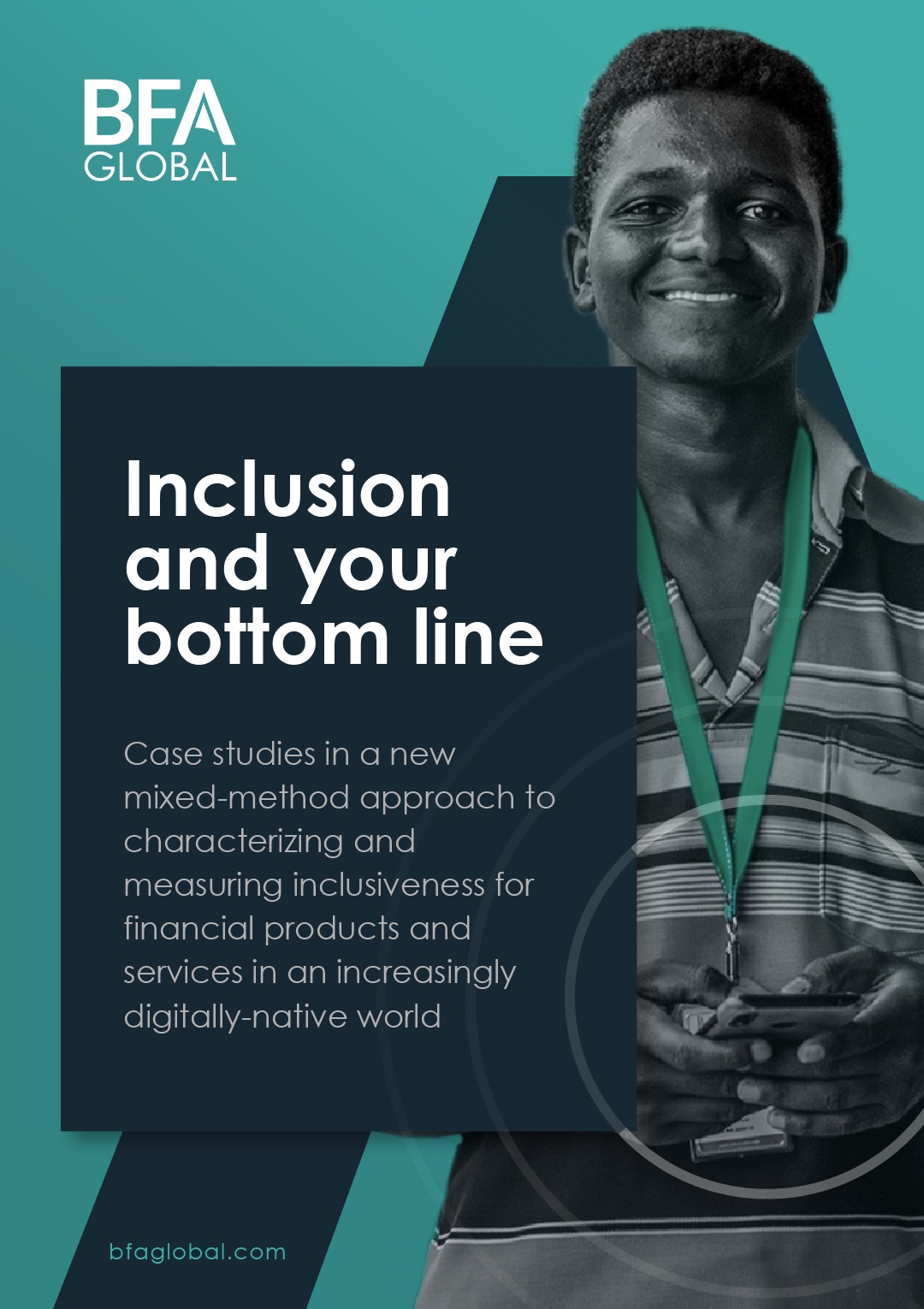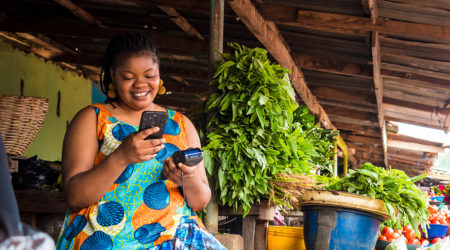People-centric profitability: how does inclusiveness impact profitability for providers?

This is the fifth case study in our report, ‘Inclusion and Your Bottom Line’, which outlines a new mixed-method approach to characterizing and measuring inclusiveness for financial products and services.
The prior several case studies in this “Inclusion and Your Bottom Line” collection have focused on the demand-side elements of the inclusiveness equation, evaluating the following characteristics: reliability, value, accessibility, and affordability. In doing so, they have also conveniently provided us with all the ingredient insights we need to deeply understand the current and projected effects on the bottom line of the supply side (i.e. viability). In other words, the goal here is to create a holistic assessment of the product by translating the demand-side driven definitions of “optimally inclusive” into maximum supply-side profitability.
Methodology
To illustrate this process, we have selected case studies conducted against dissimilar business models for transaction products of two financial providers. These particular products were selected for illustration as they: are designed to serve the mass market, have been running for one year or longer, are at least digitally-enabled (if not digital from the ground up), and exhibit room for improvement based on the demand-side studies.
- Financial Services Provider 1 (FSP1): This digitally native FSP is defined as one whose: (a) customer base is not yet at scale, although the unit costing is designed for scale, and (b) unit costs are configured for transaction-like behaviors (with embedded savings products designed to help the customer intentionally save), and customer behavior largely reflects this design. Thus, for FSP1 we focused on presenting modeling around the next 5 years’ rollup projections toward scale, and highlighting the effects of unit cost design decisions.
- Financial Services Provider 2 (FSP2): This digitally transformed FSP is defined as one whose: (a) customer base is already at scale, although a portion is dormant, and (b) unit costs are configured for savings-like behaviors (with adjacent products cross-subsidizing losses on payments-like behaviors), and customer behavior largely reflects this design. Thus, for FSP2 we focused on presenting modeling on the past 3 years of data around reduction in dormancy, and highlighting the effects of unit cost design decisions.
Unit costing analysis
We combined operational and financial information, and an activity-based costing proxy, to allocate costs and revenues to various components of the product (e.g. account, cash in/out, transactions, adjacencies, staff), resulting in a comprehensive unit economics model that followed the ACTA framework.
The allocation process focused on four main dimensions (cost drivers) to be used as the denominators in the unit cost equation:
- new accounts (which relates to the first key activity, or account origination)
- active accounts
- processing a cash-value transaction
- processing a non-cash-value transaction
We then determined the marginal contribution for the following activities to get a sense of the way each contributes to the product’s profitability:
A: opening and processing an account
C: processing cash-in and cash-out transactions
T: processing non-cash transactions
A: adjacent activities tied to a complementary portfolio (e.g. credit or premium savings products that generate offsetting revenue)
A stylized version of these resulting unit costs was then projected and plotted over time for each of the participating FSPs. As the methodology behind this particular step of the process is well-documented and similar across products and institutions, we have selected only one of the two to highlight as a unit costing case study below.
Unit costing case study – FSP1: high-volume, low-cost transactions
FSP1 is clearly focused on a business model that requires high-volume, low-fee transactions in order to be profitable. It can thus be seen as a payments processor with embedded banking features. This conclusion is in line with the growth stage this FSP is currently in, so aligning the real product with business model projections and expectations of customers is critical to achieving long-term viability.
FSP1’s business case revolves around the ability to achieve efficient operational performance at scale. According to our observations, the overall unit cost decreases substantially in the first years.
- Account origination costs decreased 65% in the second year, 25% in the third year, and subtly stabilized in the long term.
- Account maintenance costs consistently decreased rapidly in the first three years to finally show a steady behavior after the fifth year
- Transaction costs also showed a significant reduction over the years
Leveraging customers’ usage-based segmentation to project viability
Based on product usage segmentation, the BFA Global team determined how current customers’ usage of financial products might fall into several typologies. For both FSP1 and FSP2, we determined the proportion of each behavior that was observed within the product’s user base to then project the evolution of account costs when information was available.
As seen in the chart below, 60% of FSP1’s customer base would be classified as Balance Sustainers.
What is the impact on profitability for these different usage patterns? We answer this question by multiplying through the distribution of typical activities for each motif by the respective unit costs, which leaves us with a representative account-level profitability figure for that motif. We subsequently multiply these account-level motif figures by the distribution of these motifs within the portfolio, to analyze effects on profitability at the portfolio level.
Account-level analysis
At the account level, for a digitally native provider such as FSP1, in which the customer base is not yet at scale, three of the ACTA framework’s elements (CTA) hold greater potential for impacting account profitability when looking at different usage patterns. For FSP1, getting to break-even earlier will mean that a high-volume transaction account will have a greater negative impact on account profitability.
To illustrate how cash-in cash-out (CICO) and transactional components of unit costs affect profitability, we take two motifs with different transactional behaviors and relatively similar average balance levels. The transactional volume hurts profitability significantly due to the high contribution margin seen in the first four years. After breaking even in year four, net transactional income holds steady despite the volume increase for both motifs.
Comparatively, looking at FSP2 in its business model maturity and the effect on the profitability of the different usage patterns, the ‘account’ element here has a crucial impact on product performance. For dormant accounts, representing almost two-thirds of its customer base, the little revenue this type of behavior brings (immaterial account average balances and intrinsic account transactional inactivity) is far from offsetting the fixed costs required to service these accounts.
On the opposite side, the two most desirable behaviors – comparably high average balances that translate into a solid interest income – offset by far the fixed costs required to serve or maintain these accounts and the amortized costs of having originated them in the first place.
Portfolio-level analysis
Another fundamental element for product profitability comes from additional income streams. In the case of FSP1, this comes from the adjacent savings and lending products. We considered penetration rates (per current account), balance growth, interest paid out, and blended interest earned by the institution’s investments to estimate the relevance of this particular element to the institution’s overall performance. We can view the overall portfolio dynamics in terms of net profitability.
In the chart below we see that savings is designed to break even (since the contribution is negligible, the orange bars are not visible in the plot) as an anchor product to attract users to an amplified portfolio, which in turn contributes to a profitable portfolio at a customer-level. Current accounts and adjacent products as loans accelerate the return a few years after both products become profitable.
When we looked across FSP2’s rollups across the entire product suite, we saw that they were profitable at the balance sheet level. However, by leveraging the motif distribution and unit costing analyses for the transaction account as listed above, we were able to examine that product’s costs in isolation. As mentioned earlier in the document, we noted a high level of dormancy, which is a significant cost with low to no returns, and also a reflection of customer challenges we noted in the survey results.
In further isolating the portion of FSP2’s portfolio that represented non-dormant accounts, we drew a secondary area for potential improvement. Despite the product being a mass-market transactional account, the unit costing reflects that of a savings product. While around half of of the customer base was indeed using this for savings behavior (i.e. Balance Sustainer, Accretive Saver), the portion using it for transactional use cases are driving significant net costs for the product. Relabeling the product in marketing, or (preferably, for the sake of inclusiveness) refining the business model to match behavior could improve the profitability of the product, and reduce reliance on revenues from adjacent products.
In the cases of both FSP1 and FSP2, the executive, financial, product strategy, and marketing teams saw the utility exhibited by this holistic approach that tied customers perspectives to product usage and their own bottom line. In both cases, they also expressed an eagerness to incorporate the findings into their respective roadmaps, which continues even to the time of writing.
Final thoughts & extending the approach
While we have typically leveraged this approach while working with one given financial service provider at a time, a formal treatment of this approach across a set of institutions has the potential to lead to extraction of valuable higher-level trends and insights as well. For instance, running these analyses across institutions varying in type (e.g. brick-and-mortar vs digital bank) or geography can be useful in comparing, contrasting, and benchmarking. Or, running across institutions in a given market could highlight competitive advantages between institutions, systemic gaps across institutions, and network effects specific to that market.
Overall, in the meantime we have consistently found this analysis can be useful in conjunction with the demand-side research to understand what competitive advantages and barriers to account adoption and usage are, and what steps the partner should take to ensure the most optimal path to viability.
READ MORE
Inclusion and your bottom line
A new mixed-method approach to characterizing and measuring inclusiveness for financial products and services, as carried out in Kenya, South Africa and Nigeria




